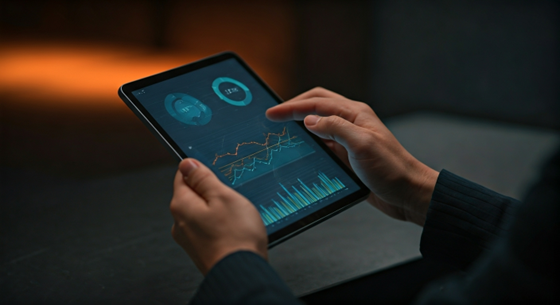Comprehensive Energy Data Management for Modern Businesses
Comprehensive Energy Data Management for Modern Businesses

Key Highlights
- Energy data management is a big part of modern business plans to use resources well and support sustainability.
- New tools like IoT, AI, and cloud systems help with better and more precise data collection, looking at the data, and making it easier to see and understand.
- This helps businesses get the most out of their energy use and make sure their equipment works well for good operational efficiency.
- Companies see good things like following rules, cutting down on carbon footprints, and keeping up with sustainability ideas.
- By using information based on energy data, businesses can lower costs, meet their goals, and improve how they do in the long run.
When companies pay attention to energy management, they get to use less energy, stop wasting so much, and spend less money too. EDM is good for both the environment and for making work smoother and faster. Now, if you want to keep up and do well in business, you need a strong way to handle your energy consumption. This will help you save money and support your green goals at the same time.
Understanding Energy Data Management in Modern Businesses

Energy Data Management (EDM) is now a big part of the energy industry. It is all about the systematic collection, looking at, and understanding energy data. With EDM, companies can check their energy usage and see where things are not working well. This helps them use their data the right way so they can make things better and save money. EDM is the heart of today’s energy management systems. It lets companies use their resources well and cut down costs.
Right now, the business world is always changing. So, there is a strong need for things like cloud platforms, AI, and IoT to help with data management for energy. These new tools make it easier to follow energy usage, support sustainability, and help with strict, stringent regulations. They also let companies build good business plans for the future. Using EDM and these new technologies means the energy industry can keep up with the times and run things better each year.
Defining Energy Data Management Systems
Energy Data Management Systems (EDMS) are key tools for any business that wants to make energy management better. These systems help with the systematic collection and use of real-time energy data from many sources like sensors, meters, and equipment performance. By cutting down on the need for manual work, EDMS can make sure people always have energy data to use for decision-making.
EDMS goes beyond just data collection. It lets businesses look at energy patterns, find common problems, and see energy trends. Firms can use this to track when energy loads are high, better manage their energy consumption, and fix issues with things that use too much energy. These findings are important for sustainability and help people in a company use good and green practices.
A strong EDMS helps smart factories and automated workplaces keep things open and work with more efficiency over the long term. With energy management in place at every step, companies can lower energy costs, shrink their carbon footprint, and help reach their sustainability goals.
Key Components and Data Sources
Energy data management has some important parts that help with easy tracking and understanding. By keeping up with data collection all the time, using sensors, meters, and other devices, businesses can see their energy use in real time. Dashboards and visualization tools help people make sense of all this energy data so they get clear and simple insights.
- Sensors: These pick up energy usage in detail. This lets businesses find any waste early on.
- Dashboards: New technology makes it easy to see energy flows with the help of simple and helpful visuals. This gives ideas for changes.
- Data Analytics: Good analytics tools let businesses look at energy usage trends, notice high-use times, and fix their workflows as needed.
- Integration: By bringing together all the parts inside energy management systems, people get to use resources well.
When you blend data from different sources, like production lines and equipment, energy data management can help businesses get the most out of their resources. It supports better energy usage, sustainability, and keeps the work flowing well.
The Strategic Importance of Energy Data in Business Operations
Energy data is important for how businesses run today. It helps companies make better choices about energy consumption, where to use their resources, and how well their equipment is working. These insights can make workflows smoother and help bring down costs.
On top of that, taking good care of energy data helps with sustainability efforts and regulatory compliance. When businesses use analytics, they can reach both their environmental and financial goals. This helps make sure they do well for a long time.
Enhancing Operational Efficiency
Optimizing workflows is one big benefit of good energy data management. When you have detailed insights into energy usage, you can spot any problems in processes or equipment. This helps you take action and make things run smoother. It can be something like recalibrating machinery or changing production schedules. With energy management systems, every choice you make is backed up by data for a bigger effect.
Advanced energy management systems help a lot with real-time monitoring. You get immediate reports on how equipment performs. This way, if there is an issue, you can deal with it at once. Doing this not only boosts operational efficiency but can also lower energy costs in your business.
As time goes on, using analytics with your energy data lets you make your optimizations even better. By always improving, you line up your resources with what production needs. This kind of work also supports sustainability and helps you with rules and standards for your business.
Supporting Sustainability and Compliance Goals
Energy data management gives you the information you need to lower greenhouse gas emissions and cut down on the overall carbon footprint. Using insights from energy data can help a business make policies to reach its sustainability goals.
- Carbon Footprint: When companies study how they use energy, they can see where to make things better and bring emissions down.
- Regulatory Compliance: Energy management systems help you follow strict environmental rules. This means you avoid fines and you also raise your company’s reputation.
- ISO Standards: These systems let you meet ISO 50001, so your energy management is well structured.
All these steps help your long-term environmental goals and make your business stronger as well. They also attract people who care about the environment and help gain customer trust.

New technologies are changing how we look at energy data management. The tools we have now help with analytics and decision-making. Many people use Internet of Things (IoT) devices, sensors, and cloud platforms for real-time data collection and easy visualization. This gives you more accuracy in tracking energy.
AI helps improve analytics, too. It looks at the data and tells you about possible trends and good chances to save. These tools make things easier, save on energy consumption, and help us follow better ways for sustainability. They help everyone in energy management to work smarter and get good results.
Role of IoT and Smart Meters
The Internet of Things (IoT) and smart meters are changing how businesses collect and use energy data. With these new tools, companies can collect data the easy way from many different types of systems and equipment. They get real-time energy data, which means they can act fast when they need to.
Smart meters use advanced sensors to keep a close eye on energy use. This gives businesses clear data to see their usage patterns each day. Also, IoT networks help pull this information together from different parts of the business. This makes it easier to spot where energy is being wasted and helps to cut down on it.
When IoT works with smart meters, it brings clear and open energy data to all in the company. Businesses can see what is going on and improve their workflows. By using these new tools, they can work towards their sustainability goals and make the way they use energy even better.
Leveraging Cloud Platforms and AI for Analytics
Cloud platforms and AI give great help when it comes to the interpretation of energy data. The cloud lets you store all your big datasets in one place. This way, you and your team can get to your data and check detailed information at different levels.
AI-powered analytics make it easier to make choices. You can use these tools to see patterns, spot things that look off, and find good chances to act. Studying energy usage trends helps people build clear plans that boost how well things work.
When you put cloud tools and AI together, you get real-time teamwork and better ways to reach sustainability and operational efficiency. This powerful mix helps everyone focus on their long-term energy management goals and improve what they do with their energy data.
Implementing Energy Data Management Solutions
Bringing in efficient energy data management means you need to plan well and carry out each step carefully. EDM systems help with easy energy data collection, use, and reporting. This lets organizations make their workflows better and get good results.
When these solutions are t in place, they help the way people work fit with their sustainability goals. They also help the business follow even the most stringent regulations. Using advanced tools like dashboards and analytics, companies can keep things more open and clear. This also gives them lasting benefits when it comes to how they use resources.
Steps to Successful Integration
Integrating energy data management systems demands a systematic approach to ensure success. A carefully planned workflow guarantees smooth implementation, enhancing energy monitoring across operations.
| Steps to Integration | Details |
|---|---|
| Assessments | Evaluate current systems and energy efficiency levels |
| Solution Selection | Choose EDM systems tailored to business needs. |
| Data Interconnectivity | Ensure seamless integration with existing workflows and IoT devices. |
| Training & Deployment | Conduct user training sessions for maximum impact. |
An effective integration strategy not only streamlines processes but also promotes transparency, supporting long-term energy sustainability.
Overcoming Common Challenges
Implementing data management systems for energy data can be hard. Many people worry about the cost and how these systems will work with what they already have. The upfront cost can look high. But over time, these systems tend to save money.
- Data Security: It is important to keep energy data safe. Using strong security helps protect all that information.
- Transparency Issues: Dashboards help a lot. They make energy data easy to see and understand, which helps solve problems with transparency.
- Technical Barriers: Sometimes, older systems do not work well with new ones. This can make it tough to get everything to work together.
If you deal with these problems right, you get better workflows. This can bring down your energy costs and make everything work better.
Conclusion
To sum up, the right approach to energy data management is very important for today’s companies. It helps to improve how things run and reach goals for sustainability. With the help of new tools like smart meters, IoT, and AI analytics, you can see your energy data and understand how your business is using energy day by day. This can help cut down costs and make sure your business is following the rules.
Having a strong energy data system lets you use what you have in a better way. It helps you make good choices and improve your results. When companies use these steps, they can stand out and stay ahead of others. If you want to make your energy plan better, talk to us to find a solution that matches what your business needs.
Frequently Asked Questions
.
What types of data are collected in energy data management?
Energy data management is about collecting detailed information as the basis for understanding energy consumption, how equipment works, and usage data from sensors. This makes real-time monitoring easy. You can then analyze things better for energy optimization.
.
How does energy data management help reduce costs?
Energy data management uses analytics to look at how the energy is being used. It helps to find the places where things are not working as well as they could. By doing this, one can change the way energy is used and make it better. This can help to lower energy bills and give a new way to manage costs in the operations. Data management helps people see what is not working, so they can use less energy and save money over time.
.
What are the challenges businesses face in managing energy data?
There are some challenges that come with energy management. You have to keep data safe. You also need to connect different systems so the workflows go smooth. At the same time, it's important to follow all the stringent regulations that are set. The cost of setting up new energy management systems can be high. When you deal with these problems, it helps all things work better.
How can businesses ensure data security in energy management systems?
You can keep your data safe in energy management by using AI tools that help read and understand information. Use dashboards that have good encryption to keep data protected. It is also important to set up strong security rules in energy management systems. This will help make sure that your system is open for everyone to see but is still safe and works well. Using AI along with safe dashboards makes it easier to have both transparency and security in your daily work.
What industries benefit most from comprehensive energy data management?
Industries like manufacturing, logistics, facilities management, and energy procurement can get a lot from using strong energy data management. It helps to use resources in a better way. This also backs up sustainability goals and lets companies do more good work with less waste. In the end, better energy data makes a big difference in how a business grows and saves money.



